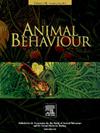When sibling tolerance meets cannibalism of the dead in spiderlings
IF 2.3
2区 生物学
Q2 BEHAVIORAL SCIENCES
引用次数: 0
Abstract
Social life requires group members to tolerate each other, which implies the presence of effective mechanisms to prevent aggression. The existence of a transient social life brings an additional dimension, as the response to social signals provided by conspecifics varies during ontogenesis. This raises questions about the mechanism driving the switch in the processing of social cues. Spiders are a relevant model for answering these questions, as juveniles are gregarious and tolerant at the start of their development and then behave aggressively towards their conspecifics at more advanced stages. Previous research has shown that spiderlings reared in groups are tolerant of their siblings, but that those maintained alone are cannibalistic. In many taxa, the nutritional status of individuals plays an important role in the expression of intraspecific aggression. We found that in juveniles of the solitary spider Agelena labyrinthica, lipid stores decreased over time when starved, but social context did not have any effect. This suggests that differences in energy stores do not cause differences in how individuals interact with each other. We then examined whether spiderlings that tolerated living siblings cannibalized corpses immediately after death or after a 24 h delay. We found that spiders engage in necrophagy at a similar rate, regardless of the age of the corpse. These results suggest that living spiders produce an as-yet-undetermined signal that protects them from cannibalism but disappears immediately after their death, exposing them to predation by siblings.
当兄弟姐妹的宽容遇到了蜘蛛幼虫的同类相食
社会生活要求群体成员相互容忍,这意味着存在有效的机制来防止攻击。短暂社会生活的存在带来了额外的维度,因为在个体发生过程中,对同种个体提供的社会信号的反应是不同的。这就引发了人们对社会线索处理过程中驱动这种转变的机制的疑问。蜘蛛是回答这些问题的一个相关模型,因为幼蛛在发育初期是群居的和宽容的,然后在更高级的阶段对它们的同类表现出攻击性。先前的研究表明,成群饲养的蜘蛛能容忍它们的兄弟姐妹,但单独饲养的蜘蛛则会同类相食。在许多分类群中,个体的营养状况在种内攻击行为的表达中起着重要的作用。我们发现,在孤独的迷路Agelena稚蛛中,脂质储存随着饥饿时间的推移而减少,但社会环境没有任何影响。这表明能量储存的差异并不会导致个体之间相互作用的差异。然后,我们检查了能够容忍活着的兄弟姐妹的蜘蛛是在死后立即吃尸体还是在24小时后吃尸体。我们发现,无论尸体的年龄如何,蜘蛛都以相似的速度进行噬尸。这些结果表明,活着的蜘蛛会产生一种尚未确定的信号,这种信号可以保护它们免受同类相食的伤害,但在它们死后会立即消失,使它们暴露在兄弟姐妹的捕食之下。
本文章由计算机程序翻译,如有差异,请以英文原文为准。
求助全文
约1分钟内获得全文
求助全文
来源期刊

Animal Behaviour
生物-动物学
CiteScore
4.60
自引率
8.00%
发文量
236
审稿时长
10.2 weeks
期刊介绍:
Growing interest in behavioural biology and the international reputation of Animal Behaviour prompted an expansion to monthly publication in 1989. Animal Behaviour continues to be the journal of choice for biologists, ethologists, psychologists, physiologists, and veterinarians with an interest in the subject.
 求助内容:
求助内容: 应助结果提醒方式:
应助结果提醒方式:


